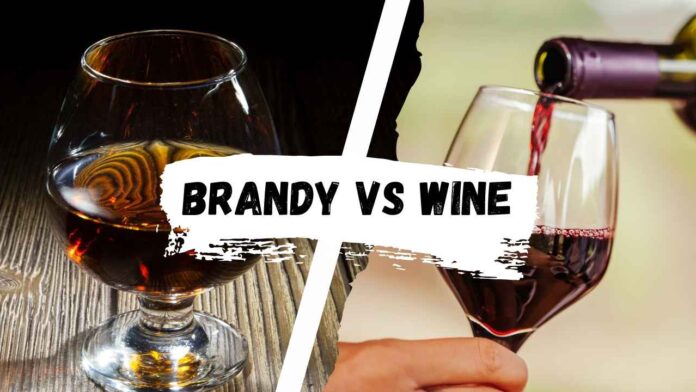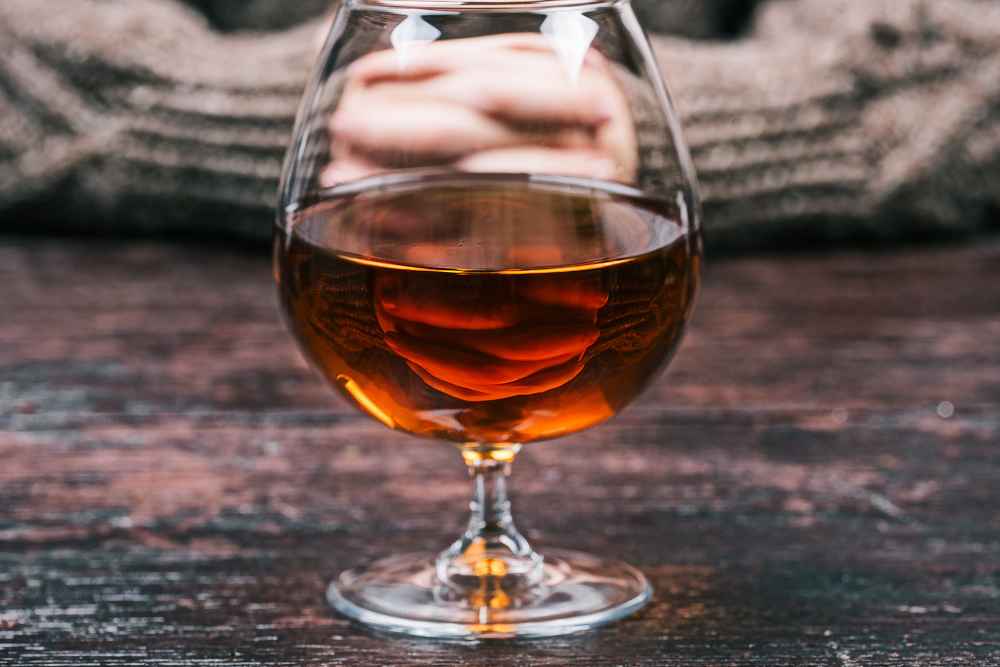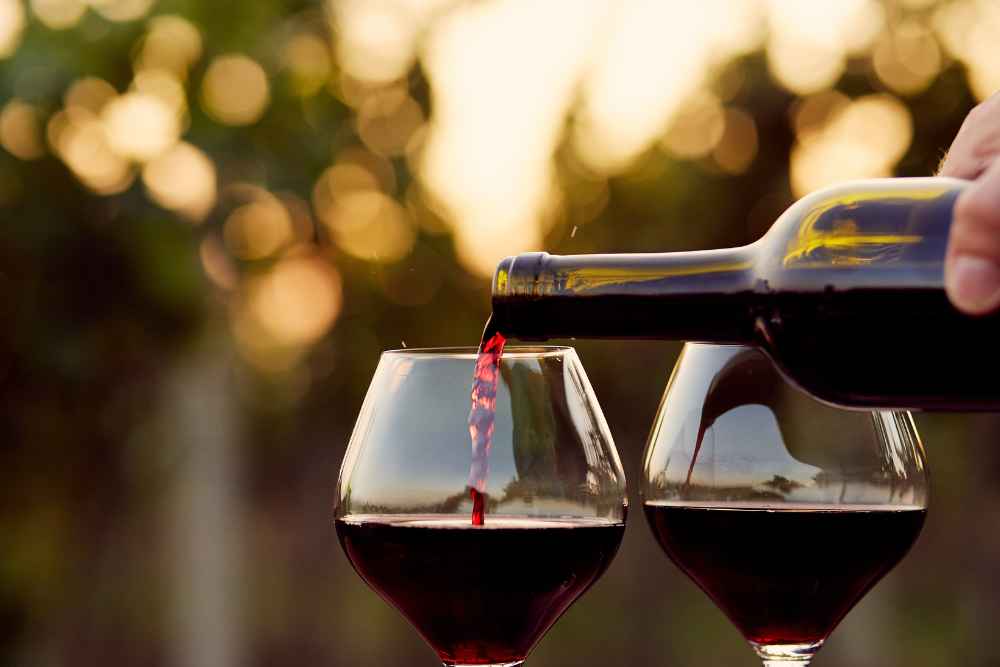This page may contain affiliate links. Please see our Disclaimer for more information. Always drink responsibly and adhere to your local legal drinking age.
Introduction
Welcome to the fascinating world of brandy and wine, two different beverages that share a common heritage but offer unique experiences! In this side-by-side comparison, we’ll uncover their similarities and differences while exploring their history, production processes, flavor profiles, and ideal pairings.
From Cognac’s luxurious sophistication to wine’s endless variety, each offers its allure. Ready to dive into the captivating universe of these grape-based libations? Join us as we toast the joys of brandy vs wine.
Key Takeaways:
- Brandy is a distilled alcoholic beverage made from fermented fruit juice, pulp, or marc. Wine, on the other hand, is a fermented beverage made from grapes or other fruits.
- While brandy and wine are aged in wooden barrels to enhance their flavors and characteristics, brandy has a longer maturation period than most wines.
- Brandy typically has a higher alcohol content ranging from 35-60% ABV, compared to wine which ranges from 5-20% ABV. Consuming both beverages in moderation is important for optimal health benefits and avoiding any potential risks associated with excessive alcohol consumption.
- Both brandy and wine offer unique flavor profiles that can be enjoyed independently or paired with meals. Understanding the differences between them can help individuals make an informed decision about which one best suits their tastes and preferences.
Understanding Brandy And Wine
Brandy is a distilled alcoholic beverage, essentially the high-octane cousin of wine, while wine is a typical fermented beverage made from grapes.
Definition And History Of Brandy
Brandy, a distilled spirit made from fermented fruit juice, pulp, or marc, has a rich and storied history that dates back centuries.
Distilled spirits such as brandy gained popularity during the Middle Ages as trade routes expanded and more people were exposed to different types of alcohol.
Most notably known for being distilled from grapes or apples today, early brandy versions were created using any available fermentable fruit. Over time, specific regions developed their distinctive styles based on local ingredients and production methods—Cognac from France and Calvados (apple brandy) from Normandy are two examples of highly regarded regional variations.
Types Of Brandy
There is a diverse world of brandy types that cater to the tastes and preferences of cocktail drinkers. Some popular kinds of brandy include:
- Cognac: Distilled from specific grape varieties in the Cognac region of France, this brandy is aged in oak barrels and is highly sought after for its complex flavors and aromas.
- Armagnac: Similar to Cognac but produced in the Armagnac region of France, it has a more robust flavor profile due to its single distillation process.
- Grappa: An Italian brandy made from the pomace (seeds, stems, and skins) left over after winemaking, grappa offers unique and intense flavors.
- Pisco: A fragrant South American brandy typically made from Muscat grapes, pisco is gaining popularity for its use in cocktails like the Pisco Sour.
- Calvados: Originating from Normandy, France, Calvados is an apple-based brandy that boasts rich apple flavors with hints of oak and spice.
- Applejack: Often called America’s first distilled beverage, applejack is an apple brandy typically produced through freeze distillation or fractional crystallization.
- Fruit Brandies: Made using a variety of fruits such as peach, cherry, or apricot, fruit brandies can offer a wide range of delicious flavors perfect for sipping or mixing in cocktails.
Each brandy type brings unique characteristics to any cocktail creation while showcasing diverse production methods and regional influences.
How Brandy Is Made
Making brandy begins with fermented fruit, typically grapes, but other fruits such as apples and pomace can also be used. Initially, the fruit is crushed and then allowed to ferment into wine.
During distillation, low wine is produced from an initial round of heating and vaporization. This first run-through has lower alcohol content than desired for the final product.
It goes through another round known as double distillation to increase its potency. The resulting high-proof spirit called “eau de vie” or “water of life” may range between 35-60% ABV (alcohol by volume).
After this stage, brandy enters oak barrels for aging, acquiring its distinct aroma profile and darker coloration from barrel materials like French Limousin oak.
Definition And History Of Wine
Wine is a fermented alcoholic drink made from grapes or other fruits, such as cherries, pomegranates, and apples. The drink dates back to ancient times when grapevines were first cultivated in the Middle East around 6000 BC.
From there, wine spread throughout Europe, with the Romans introducing it to France and Spain.
The process of making wine involves crushing harvested grapes into juice that is then left to ferment naturally or with added yeast for several weeks. During fermentation, sugar from the fruit turns into alcohol resulting in an average alcohol content of 9-12% ABV in most wines.
Red wine comes from fermenting red-skinned grapes, while white wine uses greenish-yellow grapes or red-skinned grapes where the skins have been removed before fermentation begins.
Types Of Wine
There are various types of wine, each with its unique characteristics and flavor profiles. Here are some common types of wine:
- Red Wine: This wine is made from dark-colored grapes and is usually heavier and fuller-bodied than other wines.
- White Wine: White wine is made from green or yellow grapes and has a light-bodied, crisp taste.
- Rosé Wine: Rosé wine has a pink hue obtained by leaving the grape juice in contact with the skins for a short time.
- Sparkling Wine: Carbon dioxide added during fermentation makes this wine fizzy and bubbly.
- Fortified Wine: This type of wine has an added alcohol content due to the addition of spirits like brandy.
- Dessert Wine: This sweet, syrupy wine is usually consumed after dinner as a dessert accompaniment.
- Organic Wine: Made from organically grown grapes without chemicals or pesticides.
Each type of wine can also have different varieties based on the grape used, production region, fermentation process, aging process, and other factors altering its flavor profile.
How Wine Is Made
Wine is a popular alcoholic beverage made from fermented grapes. The winemaking process begins with harvesting ripe grapes, which are then crushed to extract the juice.
The grape juice is left to ferment, meaning that natural yeast on the grape skins converts the sugar into alcohol.
After fermentation, the wine is separated from sediment or solids and transferred into oak barrels for aging. Oak barrels are commonly used because they impart flavors and aromas to the wine while allowing for slow oxidation during aging.
Production Process
Brandy is produced through distillation, while wine is made through fermentation.
Distillation Process For Brandy
The distillation process is what turns fermented wine into brandy. After the wine has been aged for a certain amount of time, it is then distilled in a copper still or pot to separate the alcohol from the water and other impurities.
The clear liquid produced as a result is then aged in oak barrels for several years to impart flavor and color. This aging process can last anywhere from six months to several decades, depending on the type of brandy being made.
Examples of popular types include cognac, Armagnac, and calvados.
Fermentation Process For Wine
During the fermentation process for wine, yeast is added to freshly pressed grape juice. The yeast consumes the sugars in the juice and converts them into alcohol, creating a chemical reaction that produces carbon dioxide gas.
For red wines, this fermentation process includes crushed grape skins which contain tannins that give it its color and flavor profile, while white wines are made solely from fermenting grape juice without skin contact.
Winemakers may also add their desired amounts of oak chips or other flavors during aging to achieve specific flavor profiles.
Alcohol Content And Aging
Brandy has a higher alcohol content than wine, with an ABV of 35-60%, while wine typically ranges from 5-20%.
Alcohol Content Of Brandy Vs Wine
When comparing alcohol content levels, brandy has a higher concentration than wine due to its distillation process with 35-60% ABV, while wine has a comparatively lower percentage.
| Type | Alcohol Content (ABV) |
|---|---|
| Brandy | 35-60% |
| Wine | 5-15% |
This difference in alcohol content is significant, as consuming higher levels of alcohol can harm one’s health and increase the chances of developing sleep conditions or other health issues. It is essential to consider these factors when choosing a beverage and consuming it responsibly.
Aging Process For Brandy Vs Wine
The aging process for brandy and wine significantly impacts their flavors and characteristics, with both beverages maturing in wooden containers. Let’s take a closer look at their respective aging processes.
| Brandy | Wine |
|---|---|
| Brandy typically has a longer maturation period, ranging from a few years to several decades. | Wine generally matures for a shorter duration, with most wines aged two to three years. |
| The aging process for brandy involves resting in oak barrels, which imparts flavors and colors that enhance the overall profile of the spirit. | Wine is also aged in wooden barrels, often oak, which allows subtle flavors and tannins from the wood to integrate into the wine. |
| As brandy ages, it becomes smoother and more complex, with the flavors developing and deepening. | The aging of wine can improve its quality, but it does not always guarantee better taste or quality, as some wines are meant to be consumed young. |
| Brandy is categorized by age, with younger brandies used for cocktails and older, more refined ones enjoyed straight. | Wine can also be classified by age, but this is not as standard as with brandy, as different wine styles are intended to be enjoyed at various stages of maturity. |
| The alcohol content in brandy may remain consistent over time, as the aging process mainly affects flavors and complexity. | The alcohol content in wine can change slightly during the aging process due to evaporation, but this is not a major factor in the overall character of the wine. |
Both brandy and wine have unique aging processes that contribute to their distinct flavors and characteristics. While the aging duration and methods may differ, it’s essential to appreciate the artistry behind each beverage and enjoy its rich flavors responsibly.
Flavor And Aroma
Brandy and wine have distinct flavor profiles and aromas due to their unique production processes, making them both enjoyable in very different ways.
Flavor Profiles Of Brandy Vs Wine
The diverse flavors and aromas in both brandy and wine make them a delight to the senses. Each type of brandy and wine has its unique profile, giving you a plethora of choices to find your perfect match. Below, we’ve outlined some of the key flavor profiles of brandy and wine to help you better understand their distinctions:
| Brandy | Wine |
|---|---|
| Fruity burnt wine with a pleasant oaky undertone | Varies depending on the type of wine; it can range from fruity and sweet to dry and acidic |
| Cognac: sweet, spicy, fruity, and bitter flavors, with the complexity increasing as the cognac ages | Red wine: dark fruits, berries, and spices, with a tannic finish |
| Armagnac: dried fruit, vanilla, caramel, oak, and spices | White wine: crisp, fruity, and floral; can range from sweet to dry |
| Fruit brandy: bold, bright fruit flavors, often sweet and tart | Rosé wine: fruity and refreshing, with a balance between red and white wine flavors |
| Pomace brandy: earthy, robust, and smoky, with grape and fruit flavors | Sparkling wine: lively, effervescent, with citrus, apple, and berry flavors |
| Marc brandy: strong, rustic, and fruity, with a touch of bitterness | Fortified wine: rich, sweet, and complex, with a higher alcohol content due to the addition of spirits |
As you explore the world of brandy and wine, remember that specific brands, regions, and even individual batches may offer their unique spin on the usual flavor profiles. So go ahead and savor the different nuances each bottle has to offer. Cheers!
Aroma Profiles Of Brandy Vs Wine
When it comes to aroma, brandy, and wine have distinct differences. Brandy has a rich, complex aroma and is often described as fruity burnt wine with a pleasant oakiness due to the aging process in oak barrels. Meanwhile, wine’s aroma profile varies depending on the type of grape used and its fermentation process.
White wines usually have a fruitier and floral aroma, while red wines can be more robust and earthy. The aromas of brandy and wine play an essential role in their overall taste experience. Wine aromas are activated by the warmth of the mouth while sipping, whereas brandy’s warm flavor profile is present from the start. The delicate balance between these two factors contributes to making each drink unique from one another.
Serving And Pairing Suggestions
Pair a glass of brandy with dark chocolate or strong cheeses for a decadent and delicious dessert; white wine pairs well with pasta dishes, roasted meats, and lighter desserts like fruit tarts or sorbets.
Recommended Serving And Pairing For Brandy
For those who enjoy brandy, knowing how to serve and pair it correctly is important. Here are some recommendations:
- To enhance its aroma, serve brandy at room temperature or slightly warmed in a tulip-shaped glass.
- Pair brandy with dark chocolate or dried fruit for a delicious dessert pairing.
- Try serving brandy with sharp-aged cheeses or roasted nuts for a savory pairing.
- Duck is a recommended meat pairing due to its richness and flavor, which complements the brandy’s aroma and taste.
- When using brandy as an ingredient in cocktails, pair it with ingredients like ginger, maple syrup, or citrus for a balanced flavor profile.
Remember to drink responsibly and never overindulge in alcohol.
Recommended Serving And Pairing For Wine
When it comes to wine, proper serving and pairing can make all the difference in your drinking experience. Here are some expert recommendations for serving and pairing different types of wine:
- Cabernet Sauvignon: Serve at room temperature (around 60-65°F) and pair with red meats, cheeses, and rich sauces.
- Pinot Noir: Serve slightly chilled (around 55°F) with chicken or pork dishes, earthy vegetables, and mushroom-based sauces.
- Chardonnay: Serve chilled (around 45-50°F) and pair with seafood, creamy pasta dishes, and light cheeses.
- Sauvignon Blanc: Serve chilled (around 40-45°F) and pair with light salads, seafood dishes, and tangy cheeses.
- Malbec: Serve at room temperature (around 60-65°F) and pair with spicy dishes, grilled meats, and hard cheeses.
- Champagne/Sparkling Wine: Serve chilled (around 40-45°F) and pair with appetizers like oysters or caviar and light desserts like fruit tarts or sorbets.
Remember to consider the aromas and flavors of the wine and the food when pairing them together – a well-paired combination should complement each other’s tastes rather than overpower one another.
Health Benefits And Risks
Brandy and wine have both been associated with health benefits when consumed in moderation, such as reducing the risk of heart disease and improving cognitive function. However, excessive consumption of either can lead to adverse health effects, including liver damage and addiction.
Benefits Of Moderate Consumption Of Brandy And Wine
Moderate consumption of alcohol, including brandy and wine, has been linked to potential health benefits. Recent studies have shown that average alcohol consumption may have protective health benefits, including reducing the risk of heart disease. Brandy contains antioxidants to help lower bad cholesterol levels and promote heart health. Meanwhile, red wine is known for its high concentration of polyphenols, which help protect against chronic conditions such as diabetes and certain cancers. However, it’s important to note that the benefits of alcohol consumption may not apply to everyone, and heavy drinking can lead to serious health risks. So always remember to enjoy your drink in moderation!
Risks Of Excessive Consumption Of Brandy And Wine
It’s no secret that excessive consumption of alcohol, including brandy and wine, can lead to serious health problems. Liver diseases such as cirrhosis, cancer, violence, and weight gain are among the risks associated with heavy drinking. Binge drinking or consuming more than 5 drinks in one sitting can also result in irreversible harm to vital organs like the liver and heart. Meanwhile, moderate drinking is often linked to a reduced risk of developing type 2 diabetes and heart disease. Cocktail drinkers must be mindful of their alcohol intake and avoid excessive consumption while enjoying their favorite beverages responsibly.
Popular Brands And Varieties
Some top brandy brands and varieties include Hennessy, Remy Martin, Courvoisier, and Martell.
Top Brandy Brands And Varieties
If you’re a cocktail drinker looking to try out some of the best brandy brands and varieties, here are some recommendations:
- Hennessy – A well-known brand that produces high-quality cognac.
- Remy Martin – Another popular cognac brand that has been around since 1724.
- Korbel – A California-based brand that produces various types of brandy, including grape, apple, and peach.
- Cardenal Mendoza – Produced in Spain, this brandy is known for its rich flavor and complex aroma.
- Martell – One of the oldest cognac houses in France, Martell offers various blends and vintages.
- Metaxa is a Greek brandy that has been around for over 130 years, known for its smooth taste and distinctive bottle design.
- Torres – Produced in Spain, Torres offers various aged brandies with varying flavor profiles.
- St-Remy – A French brand that produces VSOP and XO blends using grapes from the Cognac region of France.
- Hine – An English brand producing cognac since 1763, known for its elegant and refined taste.
- E&J Gallo – A California-based winery that also produces various grape-based brandy at an affordable price point.
These are just a few examples of top-rated brandy brands and varieties to consider when exploring the world of this classic spirit.
Top Wine Brands And Varieties
If you’re a cocktail drinker looking to expand your palate, here are some of the top wine brands and varieties to try:
- Cabernet Sauvignon: This full-bodied red wine is known for its boldness and rich tannins. Top brands include Robert Mondavi Winery, Chateau Montelena, and Stag’s Leap Wine Cellars.
- Chardonnay: A popular white wine, Chardonnay can be oaked or unoaked with flavors of apple, pear, and vanilla. Top brands include Kistler Vineyards, Beringer Vineyards, and Domaine Leflaive.
- Pinot Noir: This light red wine has notes of cherry and raspberry with a smooth finish. Some of the top Pinot Noir brands include Domaine de la Romanée-Conti, Kosta Browne Winery, and Williams Selyem Winery.
- Sauvignon Blanc: Known for its green herbaceous aroma and crisp acidity, Sauvignon Blanc pairs well with seafood dishes. Cloudy Bay Vineyards, Kim Crawford Wines, and Dog Point Vineyard are top brands.
- Zinfandel: A bold red wine with high alcohol content, Zinfandel has flavors of blackberry jam and black pepper. Top brands include Turley Wine Cellars, Ridge Vineyards, and Seghesio Family Vineyards.
- Riesling: A sweet white wine with apricot and honeycomb flavors that pair well with spicy foods. Top Riesling brands include Egon Müller-Scharzhof, Trimbach, and Joh.Jos.Prüm.
- Syrah/Shiraz: This full-bodied red wine has flavors of blackberry and smoked meat with a peppery finish. Some top Syrah/Shiraz brands include Penfolds Grange Bin 95 Shiraz, Guigal Côte-Rôtie La Landonne, and Colgin Cellars.
- Rosé: A refreshing pink wine with strawberries, citrus, and watermelon flavors. Top Rosé brands include Miraval Côtes de Provence Rosé, Whispering Angel Côtes de Provence Rosé, and Charles & Charles.
Whether you’re looking for a bold red or a crisp white, these top wine brands and varieties will satisfy your taste buds.
FAQ
Q: What is the difference between wine and brandy?
A: While both wine and brandy are made from grapes, wine is fermented grape juice that is not distilled, whereas brandy is a distilled alcohol made from concentrated wine.
Q: How is wine made?
A: Wine is made by crushing grapes and fermenting the juice with yeast, converting the sugar into alcohol. The resulting product is fermented grape juice with an alcohol content of around 12-14%.
Q: What is distilled wine?
A: Distilled wine is a wine that has been heated to produce steam, which is then collected and cooled back into a liquid through a process called condensation. This concentrated wine is then aged to create brandy.
Q: What is the base wine used to make brandy?
A: The base wine used to make brandy can come from any grape variety, but grapes grown specifically for brandy production tend to have higher acidity and lower sugar content.
Q: How is brandy produced?
A: Brandy is produced by distilling wine in a pot still, which separates the alcohol from the water and concentrates the flavor and aroma of the grape. The resulting clear liquid, the “heart,” is then aged in oak barrels.
Q: What types of brandy are there?
A: Brandy can be produced from any grape variety, but some of the most well-known types include cognac and Armagnac, both produced in the southwestern region of France.
Q: How does the alcohol content of brandy compare to wine?
A: Brandy has a higher alcohol content than wine, typically ranging from 35-60% ABV, compared to wine’s 12-14% ABV.
Q: Can wine be distilled into brandy?
A: Yes, wine can be distilled into brandy because it has a higher alcohol concentration than regular wine. The wine must also be made from grapes, as brandy is a grape-based distilled alcohol.
Q: What is the difference between cognac and brandy?
A: Cognac is a type of brandy produced specifically in the Cognac region of France, using a specific set of grape varieties and production methods. Brandy, on the other hand, can be produced anywhere in the world using a variety of grapes.
Q: Can other fruits be used to produce brandy?
A: Yes, brandy can be produced from a variety of other fruits, such as apples, pears, and cherries, and is commonly referred to as “fruit brandy” or “eau-de-vie.”
Conclusion
In conclusion, while brandy and wine are popular alcoholic beverages, they have distinct differences that set them apart. Brandy is a distilled liquor with a higher alcohol content than wine, making it the perfect choice for those who prefer a stronger drink.
On the other hand, the wine offers a variety of flavors and aromas that make it an excellent choice for pairing with meals or enjoying on its own. It’s important to remember the health benefits and risks associated with both drinks and to consume them in moderation.






